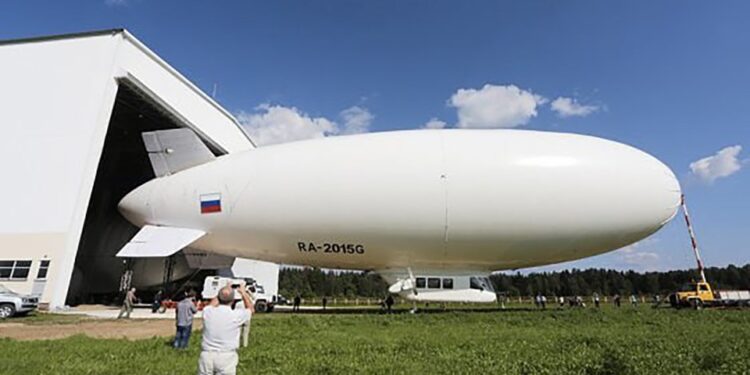VLADIMIR Putin has been deploying chilling World-War-One-style blimps on the flashpoint Nato border.
The gargantuan Zeppelin-like aircrafts have been popping up inscribed with pro-Russia propaganda in yet another attempt to intimidate the West.
The city of Narva, Estonia, has become a regular target of hybrid warfare tactics employed by mad Vlad – including surveillance blimps.
The Zepplin-like aircrafts have been popping up on almost a weekly bases meanwhile Estonian border infrastructure has disappeared in the middle of the night.
The blimps had initially been designed as anti-drone devices, launching giant nets over them before hitting their target.
But now they are instead being used solely for menacing propaganda.
Estonian cops initially chose to ignore the blimp that first appeared, sat on the Russian side of the border, hoping it wouldn’t return.
But it did – and menacingly marked with a ‘Z’ – the symbol of Putin’s bloody and illegal invasion of Ukraine.
Since then, Russia has tested its luck with the gargantuan aircraft and has dangerously flew it into Narva’s airspace – looking to instil fear in Estonia.
Egert Belitsev, director general of the Estonian police, told the Telegraph: “We are seeing things like this nearly every week.”
Tensions on the 200-mile frontier have continued to spill over in recent months.
Belitsev eerily said the blimp incident was “intentionally made visible to everyone” in order to send the message: ‘We are watching you’.
Cops say they have seen a drastic increase in border security incidents, like staged anti-West protests and attempted smuggling of drone parts.
There have also been attempts to push migrants over the Estonian border.
Russia has also been accused of bizarrely stealing buoys that mark the border on the Narva Resevoir to try and disrupt Estonia’s ability to monitor potential attacks.
In 2022, Putin appears to keep a close eye on Narva, and has even suggested it would be justifiable to “take back and secure” the border city.
Estonia joined Nato and the EU in 2004 and is said to be one of Russia’s most vocal opponents in all of Europe.
After Russia’s invasion of Ukraine in 2022, Estonia’s capital Tallinn spent more GDP per capita on military aid for Ukraine than any other country – fearful for its own safety.
Two years ago there were 18 border incidents, whereas this year there were a whopping 96, Director general of the Estonian police Belitsev told the Telegraph.
Estonia imposed restrictions at the Narva crossing point, angering Putin – and some of its citizens.
Around 96 per cent of the 56,000 population in Narva speak Russian as their first language, with 34 per cent of the population being Russian citizens.
The people therefore “live inside the Russian cultural and propaganda space,” director of Narva’s museum Dr Maria Smorzhevskikh-Smirnova told the Independent.
The restrictions imposed don’t seem to fear Putin, however, especially as tensions between Nato and Russia heat up.
Russia has closed off the Narva checkpoint to any vehicle that dare tries to cross, meaning the only way is by foot.
Just across Narva’s river – on the Russian side of the border – is the Putin-patriotic town of Ivangorod.
In May the two towns indirectly clashed as Ivangorod celebrated Victory Day, which marks the Soviet defeat of Nazism.
Indoctrinated citizens in the Russian territory set up loudpseakers and even TV screens facing across the river towards Estonia.
They blared Putin speeches and anti-Ukraine propaganda in the sinister incident.
Meanwhile in Narva, as a response, the museum put a banner up labelling Putin as a war criminal.
But pro-Russian politicians in Narva slammed the pro-Ukraine museum stunt, with the museum’s director Dr Maria Smorzhevskikh-Smirnova facing calls to be removed.
The director horrifically received rape and death threats via emails, texts and social media from Putin fans.
But she still looks to hang the poster again on next year’s Victory Day.
Just this week in Estonia’s capital Tallinn, the Nordic and Baltic leaders gathered for the annual summit of the Joint Expeditionary Force – a UK-led rapid response force that align with Nato troops.
Erkki Tori, a senior Estonian government adviser, eerily warned before the summit that there weren’t any signs that Russian aggression towards Ukraine and the West would slow down in the new year.
He said: “Russia will remain a threat for a very significant time, we don’t see any changes in the mindset of the Russian regime.”
The adviser added that Russia believes “we will become more tired” and that “they can outlast us in this war of aggression” as it “sees itself as being at war with Nato and therefore the ends justify the means”.















